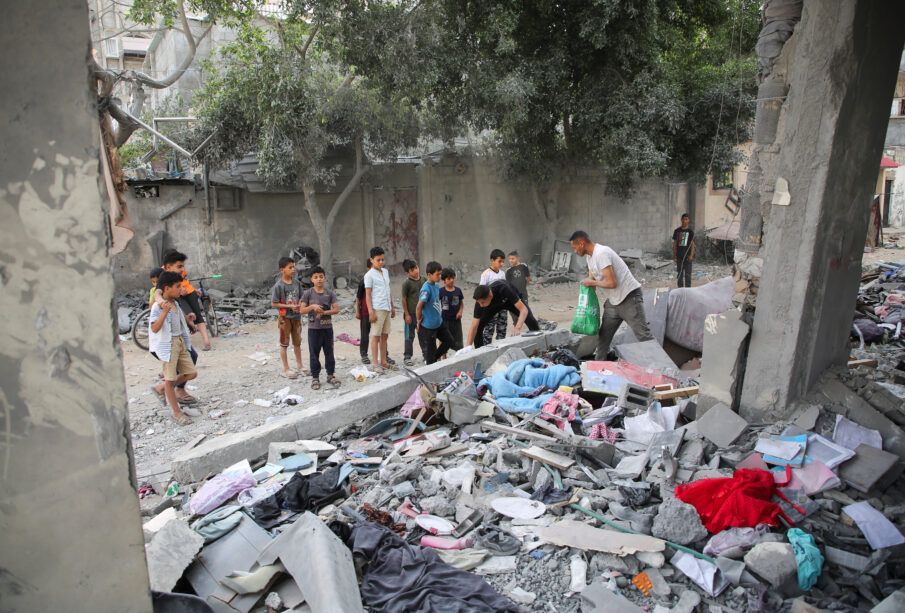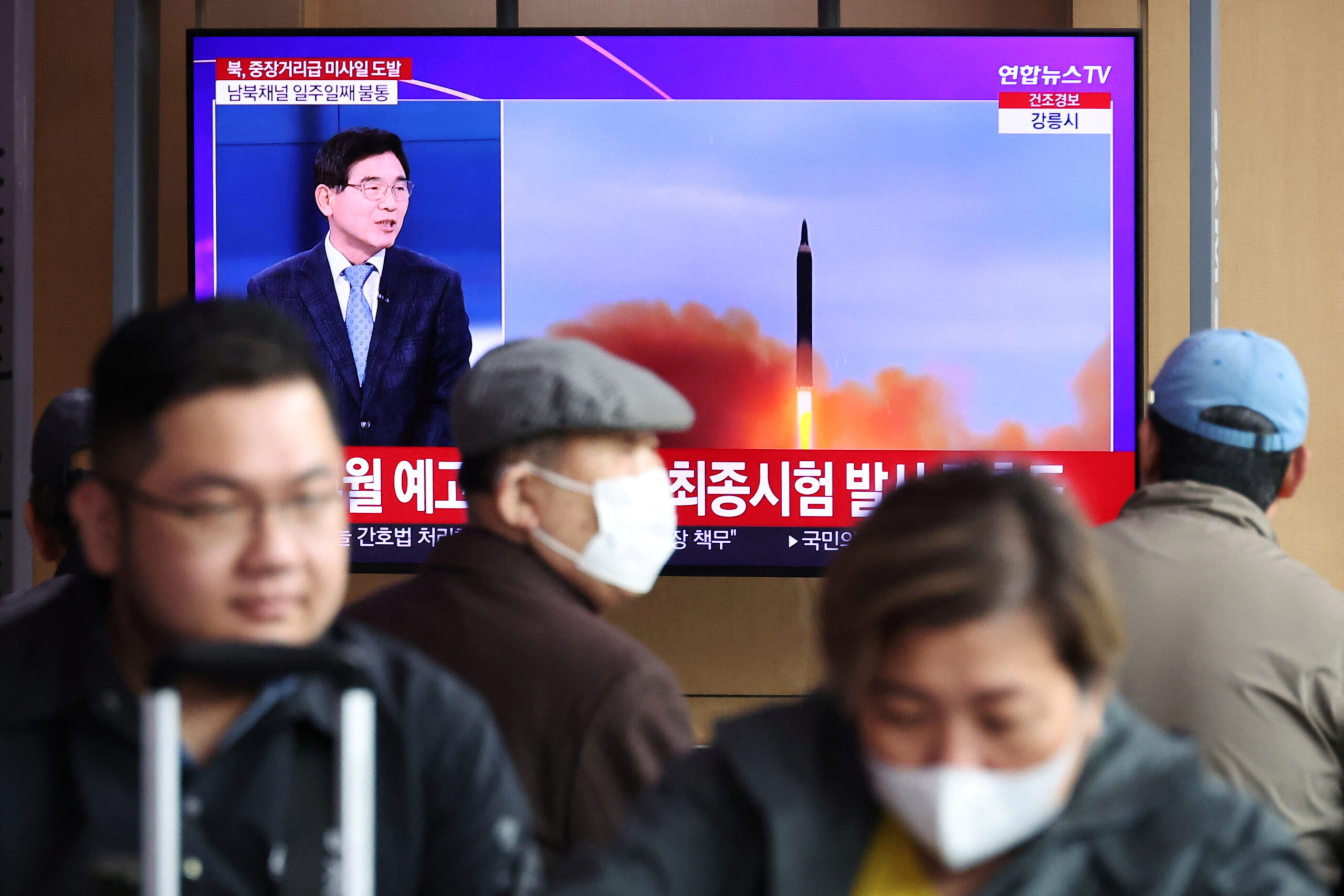Israel intensifies strikes on Rafah ahead of threatened invasion
 Palestinians inspect the site of an Israeli strike on a house, amid the ongoing conflict between Israel and the Palestinian Islamist group Hamas, in Rafah, in the southern Gaza Strip, April 25, 2024. REUTERS/Hatem Khaled
Palestinians inspect the site of an Israeli strike on a house, amid the ongoing conflict between Israel and the Palestinian Islamist group Hamas, in Rafah, in the southern Gaza Strip, April 25, 2024. REUTERS/Hatem KhaledBy Nidal Al-Mughrabi Reuters
Israel stepped up airstrikes on Rafah overnight after saying it would evacuate civilians from the southern Gazan city and launch an all-out assault despite allies’ warnings this could cause mass casualties.
Medics in the besieged Palestinian enclave reported five Israeli airstrikes on Rafah early on Thursday that hit at least three houses, killing at least six people including a local journalist.
“We are afraid of what will happen in Rafah. The level of alert is very high,” Ibrahim Khraishi, the Palestinian ambassador to the United Nations, told Reuters on Thursday.
“Some are leaving, they are afraid for their families but where can they go? They are not being allowed to go to the north and so are confined to a very small area.”
The Gaza Strip is about 40 km (25 miles) long and between about 5 km (3 miles) and 12 km (7.5 miles) wide and is one of the most densely populated areas in the world.
In the seventh month of a devastating air and ground war, Israeli forces also resumed bombarding northern and central areas of the enclave, as well as east of Khan Younis in the south. Israel’s stated goal is to destroy Hamas, though it is unclear how they would do so.
A United Nations team visiting a site for a staging area and pier for maritime aid operations was forced to take cover in a bunker on Wednesday after the area came under attack, a spokesperson said on Thursday.
They were there for “some time,” but there were no injuries.
Israeli Prime Minister Benjamin Netanyahu’s war cabinet was meeting “to discuss how to destroy the last vestiges, the last quarter of Hamas’ battalions, in Rafah and elsewhere,” government spokesperson David Mencer said.00:20What’s behind the pro-Palestinian protests at U.S. universities?
He declined to say when or whether the classified forum might give a green light for a ground operation in Rafah.
Israel has killed at least 34,305 Palestinians, Gaza health authorities said on Thursday. The offensive has laid to waste much of the widely urbanised enclave, displacing most of its 2.3 million people and leaving many with little food, water or medical care.
A U.N. expert speaking after visits to Jordan and Egypt said aid agencies were seeing an increasing number of patients suffering from the acute lack of food in the enclave.
“What I’ve seen here was traumatising. Patients that previously arrived in Egypt primarily with explosive and other war injury related symptoms are now joined by increasing numbers of patients, often children, with chronic diseases and severe malnutrition,” Francesca Albanese, the U.N. Special Rapporteur on human rights in the Occupied Territories, told reporters in Cairo.
Israel is retaliating against an Oct. 7 Hamas attack that killed 1,200 people and led to 253 taken hostage, according to Israeli tallies. Iranian-backed Hamas is sworn to Israel’s destruction due to its occupation of Palestinian territories.
Escalating Israeli warnings about invading Rafah, the last refuge for around a million civilians who fled Israeli forces further north earlier in the war, have nudged some families to leave for the nearby al-Mawasi coastal area or try to make their way to points further north, residents and witnesses said.
But many were confused over where they should go, saying their experience over the past 200 days of war had taught them that no place was genuinely safe.
Mohammad Nasser, 34, a father-of-three, said he had left Rafah two weeks ago and now lived in a shelter in Deir Al-Balah in central Gaza to avoid being caught by surprise by an Israeli invasion and unable to escape.
“We escape from one trap into another, searching for places Israel calls safe before they bomb us there. It is like the rat and trap game,” he told Reuters via a chat app.
“We are trying to adapt to the new reality, hoping it will become better, but I doubt it will.”
Shaina Low, a spokesperson for the Norwegian Refugee Council said there appeared to be fewer people in Rafah, which borders Egypt. She said teams on the ground had said people expect an invasion after the Jewish Passover holiday ends on April 30.
A senior Israeli defence official said on Wednesday Israel was poised to evacuate civilians before its attack on Rafah and had bought 40,000 tents that could house 10 to 12 people each.
Satellite images of Mawasi between Rafah, Khan Younis and the sea, an area of sand beaches and fields and stretching only around 5 by 3 km (three by two miles), showed significant camp settlements erected over the past two weeks.
BOMBING AND BODIES
Meanwhile, a Palestinian civil defence team called on the United Nations to investigate what it said were war crimes at a Gaza hospital, saying nearly 400 bodies were recovered from mass graves after Israeli soldiers left the complex in Khan Younis.
The Israeli military said allegations by Palestinian authorities that its forces had buried the bodies were “baseless and unfounded”.
In the north, Israeli forces continued to pound Beit Lahiya, Beit Hanoun, Jabalia and Zeitoun, with some residents saying Hamas and Islamic Jihad militants were fighting Israeli ground forces with anti-tank rockets, mortar bombs and sniper fire.
The Palestine Telecommunications Company said internet services had again been cut off in central and southern Gaza on Thursday, blaming Israeli military operations.
Such outages have compounded the obstacles confronting efforts to get emergency aid to stricken civilians.
An aid worker who was part of Belgium’s development efforts in Gaza died in one Israeli strike, the Belgian government said on Thursday, adding it was summoning the Israeli ambassador over the incident.











